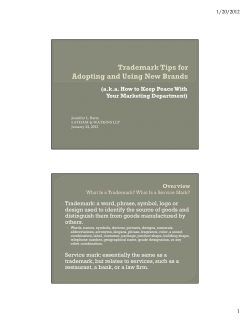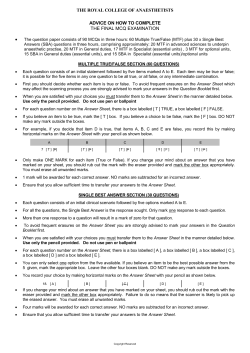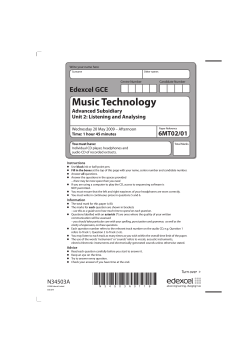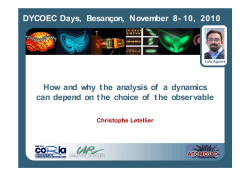
CL7103 SYSTEM THEORY QUESTON BANK UNIT I
CL7103 SYSTEM THEORY QUESTON BANK UNIT I 2 marks 1. What is state and state variable? 2. What are the advantages of state space analysis? 3. What are the drawbacks in transfer function analysis? 4. What is state diagram? 5. Draw the block diagram representation of state model. 6. Draw the signal flow representation of state model 7. Write the state model of nth order system? 8. Write the solution of homogeneous state equations 9. What are phase variables? 10. Write the canonical form of state model of nth order system. 11. Explain the concept of state and state variables. 12. Write the state model of linear time invariant systems. 13. Given the system =u ,obtain a state space model. 14. Distinguish between the following: (a) Linear & nonlinear systems (b) Time –invariant and time varying system 15. How will you choose the state variables for an electrical network consisting of R,L and C? 16 marks 1. Derive the state model of an Armature controlled DC motor. (16) 2. Derive the state model of an field controlled DC motor. (16) 3. Construct the state model of the following electrical system. (16) 4. Develop a state model for the system given by 5. A sytem has the transfer the function: FInd four different state variable models and hence demonstrate the state models are non-unique. UNIT II 2 marks 1. 2. 3. 4. 5. 6. 7. 8. 9. 10. 11. List the properties of state transition matrix. State Cayley Hamilton theorem Define the characteristic equation of a matrix What are eigen values and eigen vectors? Write properties of eigen values What is similarity transformation? What is modal matrix? What is canonical form of state model? What is Jordan matrix? How the eigen vectors are calculated when the eigen values are distinct? What is resolvant matrix? 12. Consider the system defined by =Ax where A= .Determine the Eigen values of the system matrix. 13. Determine an expression for the solution of a homogeneous stste equation using laplace transformation. 14.If A= what is . 15. Given .What is the corresponding system matrix A? 16 marks 1. For a system represented by state equation X(t)=AX(t).The response is X(t)= where X(0)= and X(t)= when X(0)= Determine the system matrix A and the state transition matrix. 2. Find the time response of the system described by the equation (t)= , 3. For the system described by the transfer function Y(s)/U(s)=1/(s2+5s+6) (i) Find the state space representation of the system (ii) Find the state transition matrix ø(t) (iii) Find the free response of the system when the initial condition is x 1 (0)=0 and x 2 (0)=1.. 4. The system matrix A of a discrete time system is given by A= Compute the state transiton matrix Ak using the Caayley Hamilton Theorem ,Compute Compute the state transiton matrix eAt using the 5.. For A= Cayley Hamilton theorem 6. A linear time invariant system is described by the following state model. = + [u] and y= Transform this sate model into a canonical state model.Also compute the state transition matrix eAt . 7.Convert the following system matrix to canonical form and hence calculate the state transition matrix eAt/ A= UNIT III 2 marks 1. Define controllability 2. Define observability 3. What is the need for observabitlity test? 4. Give two equivalent mathematical expressions which state that a given pair of matrices (A,B) is controllable 5. State the condition for controllability and observability of a system by Gilbert’s test. 6. How will you find the transformation matrix p c using the characteristics equation? 7. State the condition for controllability and observability of a system by Kalman’s test. 8. How to define stability in the sense of Lyapunov? 9. What are Lyapunov’s functions? State their significance. 10. What is minimum energy control? 16 marks 1. A system is described by [x]= [x] + [u] [y]= [x]. Test its controllability and observability 2. A control system is described by the differential equation d3y(t) /dt3= u(t),where y(t) is the observed output and u(t) is the input. (i) Describe the system in the state variable form. X=Ax+Bu , Y=Cx+Du (ii)Calculate the state transition matrix of the system. (iii) Is the system controllable? 3 Consider the following system x= x+ u and C= [1 1 2] check the observability. ii)For the system [x] = [x] + [u] Check the controllability condition. 4. The state model of a system is given by = + [u] ; Y=[1 0 0] Convert the state model to controllable phase variable form. 5. Consider a linear system described by the transfer function Y(s)/U(s) = 10/s(s+1)(s+2) Design a feedback controller with a state feedback so that the closed loop poles are placed at -2,1 ± j1 6.The state model of a system is given by = + [u] ; Y= [1 0 0] Convert the state model to observable phase variable form. 7. Convert the following state model into Jordan canonical form and therefore from comment on controllability and observability. X(t) = Y(t) = x(t) + u(t) ; x(t) 8. Consider the system = + [u] Y= [1 1 1] i) Show that the system is not completely observable. (ii)Show that the system is completely observable, if the output is given by = 9 .Show that the following system (with a fine varying B(t) matrix ) is not completely controllable. A= 1/12 ; B= UNIT IV 2 marks 1. Write the Ackermann’s formula for the determination of the state feedback gain matrix K. 2. What is the need for state observer? 3. What are Lyapunov’s functions? State their significance . 4. When a non-linear system becomes asymptotically stable? 5. What is meant by controllable companion form? 6. How to define stability in the sense of Lyapunov? 7. What is negative definiteness of scalar functions? 8. Define BIBO Stability? 9.. Define Positive definite function? 10.Write the definiteness of following scalar functions,assuming x to be two dimensional vector (a) (b) 16 marks 1. Describe Krasovski method and variable gradient method of constructing Lyapunov function 2. ) Discuss Lyapunov’s direct method for the stability analysis of non linear System 3. Determine the range of ‘k’ by applying Lyapunov x 1 =x 2 ,x 2 = -x 2 +x 3 , x 3 =-kx 1 -4x 3 And V(x)=5kx 1 2+2kx 1 x 2 +20x 2 2+8x 2 x 3 +x 3 2 4. A second order system is represented by X=AX where = assuming Q to be Solve for matrix p,in the equation ATP +PA=-Q.UÀse Lyapunov theorem & determine the stability of the origin of the system.Write the Lyapunov function V(x). 5. Determine the stability of the origin of the system described by X= Ax; A= . Let Q= UNIT V 2marks 1. How the placements of pole affect the stability of the system? 2.Write the three stages of pole placement problem. 3. Determine whether the following matrix is positive definite A= 4.Draw the schematic diagram of a state feedback control system. 5.Distinguish between root locus method and pole placement method of system design. 16 marks. 1.Describe the effect of feedback on controllability and observability 2. Explain in detail full order observer and reduced order observer 3. For the following system determine the state feedback controller that gives closed –loop eigenvalues λ 1 =λ 2 =λ 3 = -1. A = , B= 4. Consider the system defined by x=Ax+Bu; y=Cx where A= B= , C= [ ] , .Design a regulator system by the pole placement with observer approach.Assume that the closed loop poles for pole placement are located at s=-1+ j , s = 5.The desired observer poles are located at s = -6, s =-6, s= -6. Also obtain the transfer function of the observer controller 5. Consider the system described by the state model X= AX, Y=CX C= where A= ] . Design a full –order state observer.The desired eigen values for the observer matrix are µ 1 =-5; µ 2 =-5
© Copyright 2025





















